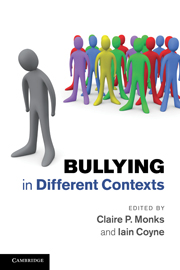Book contents
- Frontmatter
- Contents
- List of figures
- List of tables
- Notes on contributors
- 1 A history of research into bullying
- 2 Peer-victimisation in preschool
- 3 Bullying in schools: thirty years of research
- 4 Peer violence in residential children's homes: a unique experience
- 5 Domestic violence: bullying in the home
- 6 Juvenile dating and violence
- 7 Bullying in prisons: bringing research up to date
- 8 Bullying in the workplace
- 9 Elder abuse and bullying: exploring theoretical and empirical connections
- 10 Cyberbullying
- 11 An overview of bullying and abuse across settings
- Index
- References
6 - Juvenile dating and violence
Published online by Cambridge University Press: 05 June 2012
- Frontmatter
- Contents
- List of figures
- List of tables
- Notes on contributors
- 1 A history of research into bullying
- 2 Peer-victimisation in preschool
- 3 Bullying in schools: thirty years of research
- 4 Peer violence in residential children's homes: a unique experience
- 5 Domestic violence: bullying in the home
- 6 Juvenile dating and violence
- 7 Bullying in prisons: bringing research up to date
- 8 Bullying in the workplace
- 9 Elder abuse and bullying: exploring theoretical and empirical connections
- 10 Cyberbullying
- 11 An overview of bullying and abuse across settings
- Index
- References
Summary
Within the complex social world that young people inhabit, in addition to traditional forms of bullying, we find other negative forms of relations which share some characteristics with bullying in terms of dominance and submission. This is true for ‘dating violence’, which we discuss in this chapter. We explore individual factors in relation to involvement in dating violence (both aggressors and victims) and the way that the peer network can ‘cover up’ the problem. We address the roles of affective-emotional links and the appearance of interpersonal violence within the network, as well as the inclusion of negative models of couples. We propose that the appearance of dominance–submission–control–violence within the first romantic relationships during adolescence may originate in the behaviours and attitudes of the peer-group. Early data on this topic (Ortega et al., 2008b) suggest that forms of indirect relational violence may appear within dating relationships and are aimed at controlling the behaviour, attitudes and feelings of the partner, and are difficult to detect and difficult to stop. Sexual violence, on the other hand, is worryingly more present during these first dating relationships than we thought.
The importance of the first romantic relationships in adolescence
The biological changes that accompany adolescence play an important role in the changes which occur in the interpersonal relationships of adolescents. With sexual maturity, changes in the levels of hormones and the development of secondary sexual characteristics, adolescents begin to feel sexual attraction for others.
- Type
- Chapter
- Information
- Bullying in Different Contexts , pp. 113 - 136Publisher: Cambridge University PressPrint publication year: 2011
References
- 5
- Cited by



